Magnetic Field Effect on Sisko Fluid Flow Containing Gold Nanoparticles through a Porous Curved Surface in the Presence of Radiation and Partial Slip
Abstract
:1. Introduction
2. Problem Definition and Modeling
2.1. Problem Definition
2.2. Flow Analysis
2.3. Outcome of the Parameterization
2.4. Physical Parameters
3. Results and Discussion
3.1. Effect of Physical Parameters on the Velocity Profile
3.2. Effect of Physical Parameters on the Temperature Distribution
3.3. Effect of Physical Parameters on the Skin Friction Coefficient and the Nusselt Number
4. Conclusions
- The velocity of blood containing gold nanoparticles decreases with increasing intensity of an external magnetic field.
- The effect of thermal radiation can significantly modify the blood temperature. With increasing thermal radiation, the thickness of the thermal boundary layer increases significantly.
- An increase in the erythrocyte slip at the curved wall surface increases the temperature of the boundary layer.
- When suction increases in the curved wall surface, both the temperature and the velocity of blood decrease.
Author Contributions
Funding
Institutional Review Board Statement
Informed Consent Statement
Data Availability Statement
Acknowledgments
Conflicts of Interest
References
- Choi, S.U.S.; Eastman, J.A. Enhancing thermal conductivity of fluids with nanoparticles. ASME Fluids Eng. Div. 1995, 231, 99–105. [Google Scholar]
- Eastman, J.A.; Choi, U.S.; Li, S.; Thompson, L.J.; Lee, S. Enhanced Thermal Conductivity through the Development of Nanofluids. MRS Proc. 1996, 457, 3–11. [Google Scholar] [CrossRef] [Green Version]
- Sheikholeslami, M.; Ganji, D.D.; Javed, M.Y.; Ellahi, R. Effect of thermal radiation on magnetohydrodynamics nanofluid flow and heat transfer by means of two-phase model. J. Magn. Magn. Mater. 2015, 374, 36–43. [Google Scholar] [CrossRef]
- Ellahi, R.; Hassan, M.; Zeeshan, A. Shape effects of nanosize particles in Cu–H2O nanofluid on entropy generation. Int. J. Heat Mass Transf. 2015, 81, 449–456. [Google Scholar] [CrossRef]
- Sadaf, H.; Nadeem, S. Influences of slip and Cu-blood nanofluid in a physiological study of cilia. Comp. Meth. Prog. Biomed. 2016, 131, 169–180. [Google Scholar] [CrossRef] [PubMed]
- Noreen, S.; Rashidi, M.; Qasim, M. Blood flow analysis with considering nanofluid effects in vertical channel. Appl. Nanosci. 2017, 7, 193–199. [Google Scholar] [CrossRef] [Green Version]
- Ardahaie, S.S.; Amiri, A.J.; Amouei, A.; Hosseinzadeh, K.; Ganji, D.D. Investigating the effect of adding nanoparticles to the blood flow in presence of magnetic field in a porous blood arterial. Inform. Med. Unlocked 2018, 10, 71–81. [Google Scholar] [CrossRef]
- Elelamy, A.F.; Elgazery, N.S.; Ellahi, R. Blood flow of MHD non-Newtoniannanofluid with heat transfer and slip effects. Int. J. Num. Meth. Heat Fluid Flow 2020, 30, 4883–4908. [Google Scholar] [CrossRef]
- Kamal, F.; Zaimi, K.; Ishak, A.; Pop, I. Stability analysis of MHD stagnation-point flow towards a permeable stretching/shrinking sheet in a nanofluid with chemical reactions effect. Sains Malays. 2019, 48, 243–250. [Google Scholar] [CrossRef]
- Waini, I.; Ishak, A.; Groşan, T.; Pop, I. Mixed convection of a hybrid nanofluid flow along a vertical surface embedded in a porous medium. Int. Commun. Heat Mass Transf. 2020, 114, 104565. [Google Scholar] [CrossRef]
- Waini, I.; Ishak, A.; Pop, I. Hybrid nanofluid flow past a permeable moving thin needle. Mathematics 2020, 8, 612. [Google Scholar] [CrossRef]
- Waini, I.; Ishak, A.; Pop, I. Squeezed hybrid nanofluid flow over a permeable sensor surface. Mathematics 2020, 8, 898. [Google Scholar] [CrossRef]
- Huang, X.; El-Sayed, M.A. Gold nanoparticles: Optical properties and implementations in cancer diagnosis and photothermal therapy. J. Adv. Res. 2010, 1, 13–28. [Google Scholar] [CrossRef] [Green Version]
- Mekheimer, K.S.; Hasona, W.; Abo-Elkhair, R.; Zaher, A. Peristaltic blood flow with gold nanoparticles as a third grade nanofluid in catheter: Application of cancer therapy. Phys. Lett. A 2018, 382, 85–93. [Google Scholar] [CrossRef]
- Lowe, G.D.; Rumley, A. The relationship between blood viscosity and blood pressure in a random sample of the population aged 55 to 74 years. Eur. Heart J. 1993, 597, 14. [Google Scholar]
- Thurston, G.B.; Henderson, N.M. Effects of flow geometry on blood viscoelasticity. Biorheology 2006, 43, 729–746. [Google Scholar] [PubMed]
- Khan, M.; Shahzad, A. On boundary layer flow of a Sisko fluid over a stretching sheet. Quaest. Math. 2013, 36, 137.e51. [Google Scholar] [CrossRef]
- Munir, A.; Shahzad, A.; Khan, M. Convective flow of Sisko fluid over a bidirectional stretching surface. PLoS ONE 2015, 1, e0130342. [Google Scholar] [CrossRef] [PubMed]
- Khan, M.; Ahmad, L.; Khan, W.A. Numerically framing the impact of radiation on magneto nanoparticles for 3D Sisko fluid flow. J. Braz. Soc. Mech. Sci. Eng. 2017, 39, 4475.e87. [Google Scholar] [CrossRef]
- Eid, M.R.; Alsaedi, A.; Muhammad, T.; Hayat, T. Comprehensive analysis of heat transfer of gold-blood nanofluid (Sisko-model) with thermal radiation. Results Phys. 2017, 7, 4388–4393. [Google Scholar] [CrossRef]
- Ahmad, L.; Khan, M. Numerical simulation for MHD flow of Sisko nanofluid over a moving curved surface: A revised model. Microsyst. Technol. 2019, 25, 2411–2428. [Google Scholar] [CrossRef]
- Khan, U.; Zaib, A.; Shah, Z.; Baleanu, D.; Sherif El-Sayed, M. Impact of magnetic field on boundary-layer flow of Sisko liquid comprising nanomaterials migration through radially shrinking/stretching surface with zero mass flux. J. Mater. Res. Technol. 2020, 9, 3699–3709. [Google Scholar] [CrossRef]
- Inoue, S.; Kobaya, M. Biological activities caused by far infrared radiation. Int. J. Biometeorol. 1989, 33, 145–150. [Google Scholar] [CrossRef]
- Kobu, Y. Effects of infrared radiation on intraosseous blood flow and oxygen tension in rat tibia. Kobe J. Med. Sci. 1999, 45, 27–39. [Google Scholar] [PubMed]
- Nishimoto, C.; Ishiura, Y.; Kuniasu, K.; Koga, T. Effects of ultrasonic radiation on cutaneous blood flow in the paw of decerebrated rats. Kawasaki J. Med. Welfare 2006, 12, 13–18. [Google Scholar]
- He, Y.; Shirazaki, M.; Liu, H.; Himeno, R.; Sun, R. A numerical coupling model to analyze the blood flow, temperature, and oxygen transport in human breast tumor under laser irradiation. Comput. Biol. Med. 2006, 36, 1336–1350. [Google Scholar] [CrossRef]
- Prakash, J.; Makinde, O.D. Radiative heat transfer to blood flow through a stenotic artery in the presence of magnetic field. Lat. Am. Appl. Res. 2011, 41, 273–277. [Google Scholar]
- Misra, J.C.; Sinha, A. Effect of thermal radiation on MHD flow of blood and heat transfer in a permeable capillary in stretching motion. Heat Mass Transf. 2013, 49, 617–628. [Google Scholar] [CrossRef] [Green Version]
- Khan, U.; Shafiq, A.; Zaib, A.; Sherif El-Sayed, M.; Baleanu, D. MHD radiative blood flow embracing gold particles via a slippery sheet through an erratic heat sink/source. Mathematics 2020, 8, 1597. [Google Scholar] [CrossRef]
- Zaib, A.; Khan, U.; Wakif, A.; Zaydan, M. Numerical entropic analysis of mixed MHD convective flows from a non-isothermal vertical flat plate for radiative tangent hyperbolic blood biofluids conveying magnetite ferroparticles: Dual similarity solutions. Arabian J. Sci. Eng. 2020, 45, 5311–5330. [Google Scholar] [CrossRef]
- Chen, I.H. Analysis of an intensive magnetic field on blood flow: Part 2. J. Bioelectr. 1985, 4, 55–61. [Google Scholar] [CrossRef]
- Koriko, O.K.; Animasaun, I.; Mahanthesh, B.; Saleem, S.; Sarojamma, G.; Sivaraj, R. Heat transfer in the flow of blood-gold Carreau nanofluid induced by partial slip and buoyancy. Heat Transf. Asian Res. 2018, 47, 806–823. [Google Scholar] [CrossRef]
- Roşca, N.C.; Pop, I. Unsteady boundary layer flow over a permeable curved stretching/shrinking surface. Eur. J. Mech. B/Fluids 2015, 51, 61–67. [Google Scholar] [CrossRef]
- Saleh, S.H.M.; Arifin, N.M.; Nazar, R.; Pop, I. Unsteady micropolar fluid over a permeable curved stretching shrinking surface. Math. Prob. Eng. 2017, 2017, 3085249. [Google Scholar] [CrossRef]
- Abbas, Z.; Naveed, M.; Sajid, M. Heat transfer analysis for stretching flow over a curved surface with magnetic field. J. Eng. Thermophys. 2013, 22, 337–345. [Google Scholar] [CrossRef]
- Waini, I.; Ishak, A.; Pop, I. Flow and heat transfer along a permeable stretching/shrinking curved surface in a hybrid nanofluid. Phys. Scr. 2019, 94, 105219. [Google Scholar] [CrossRef]
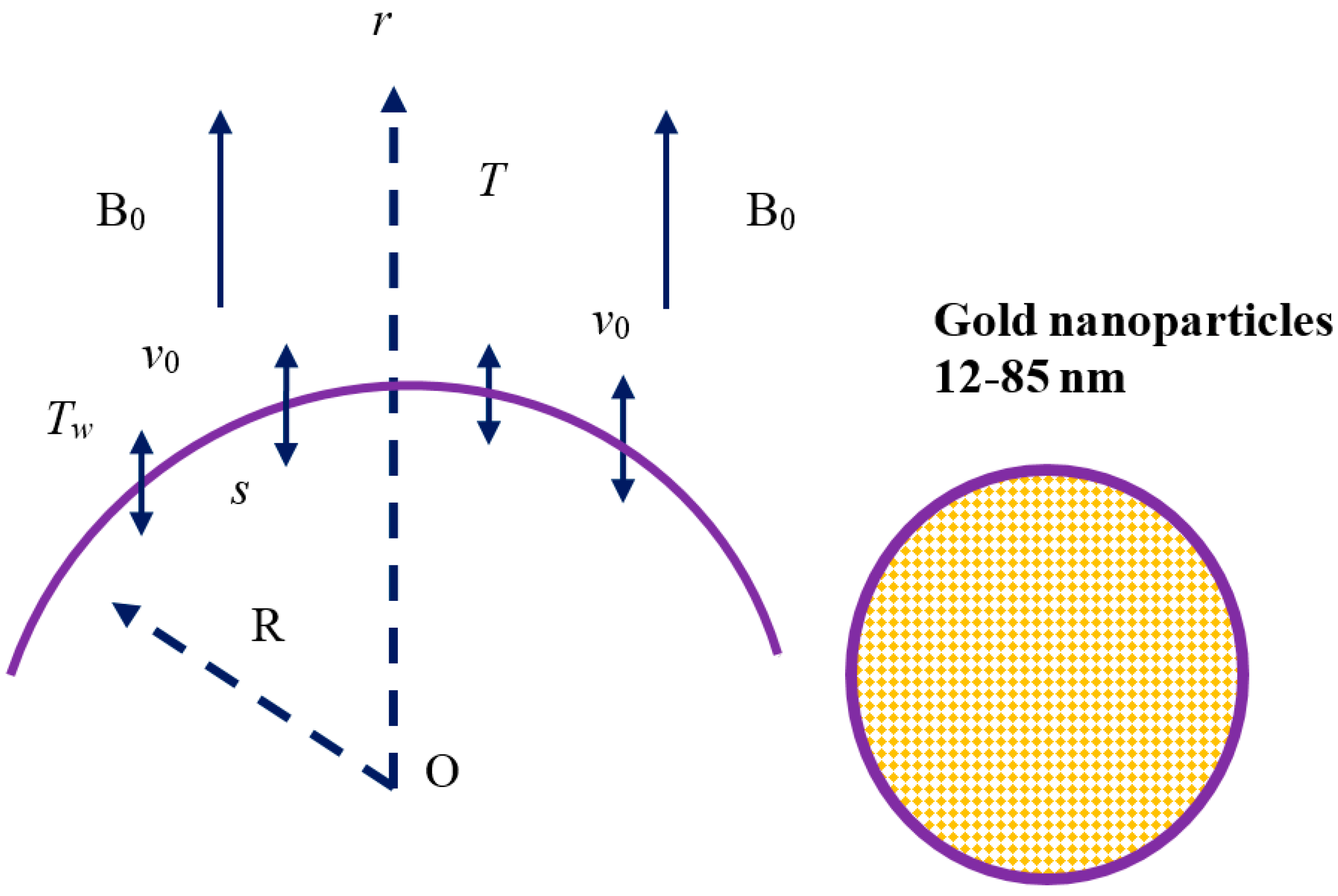

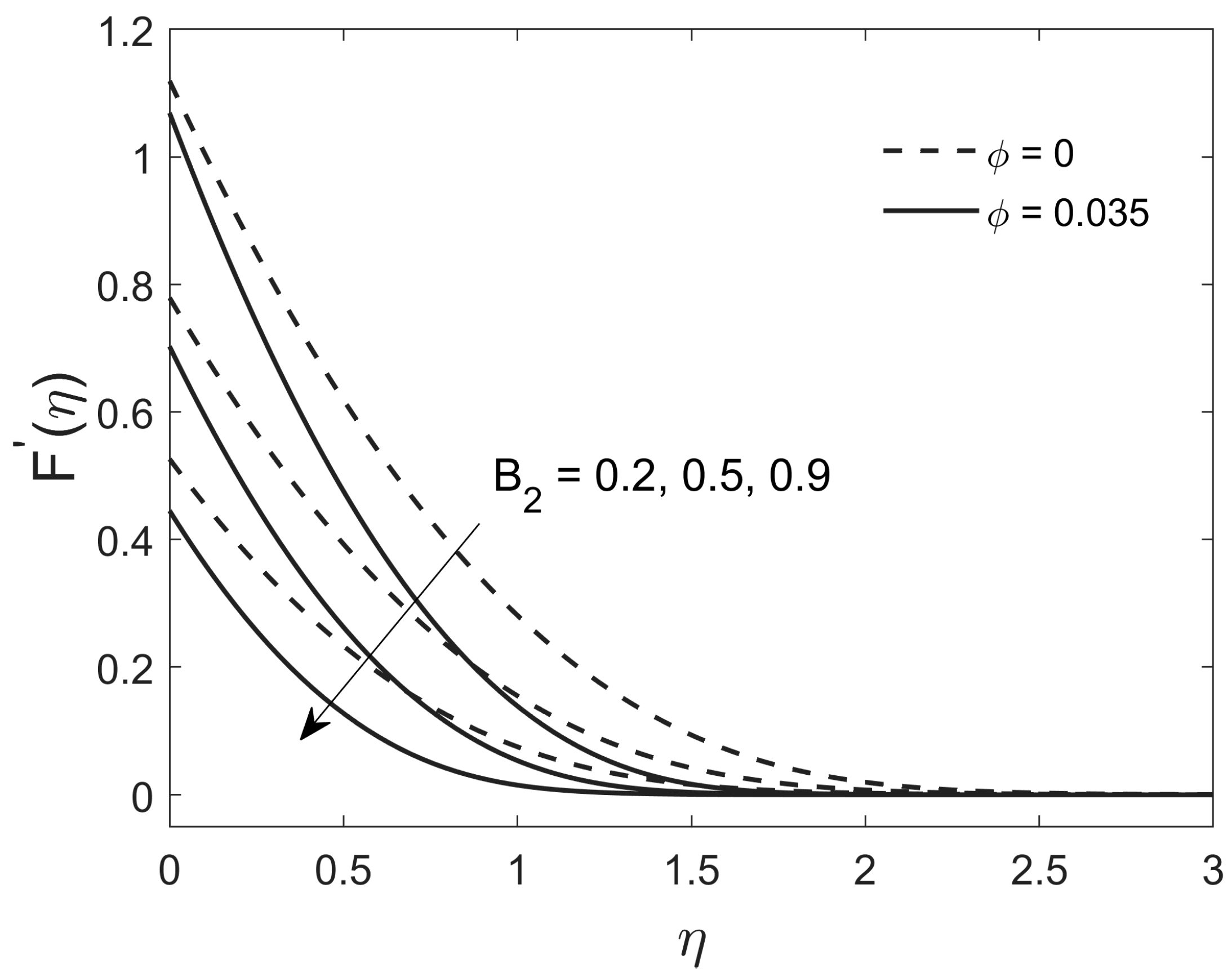
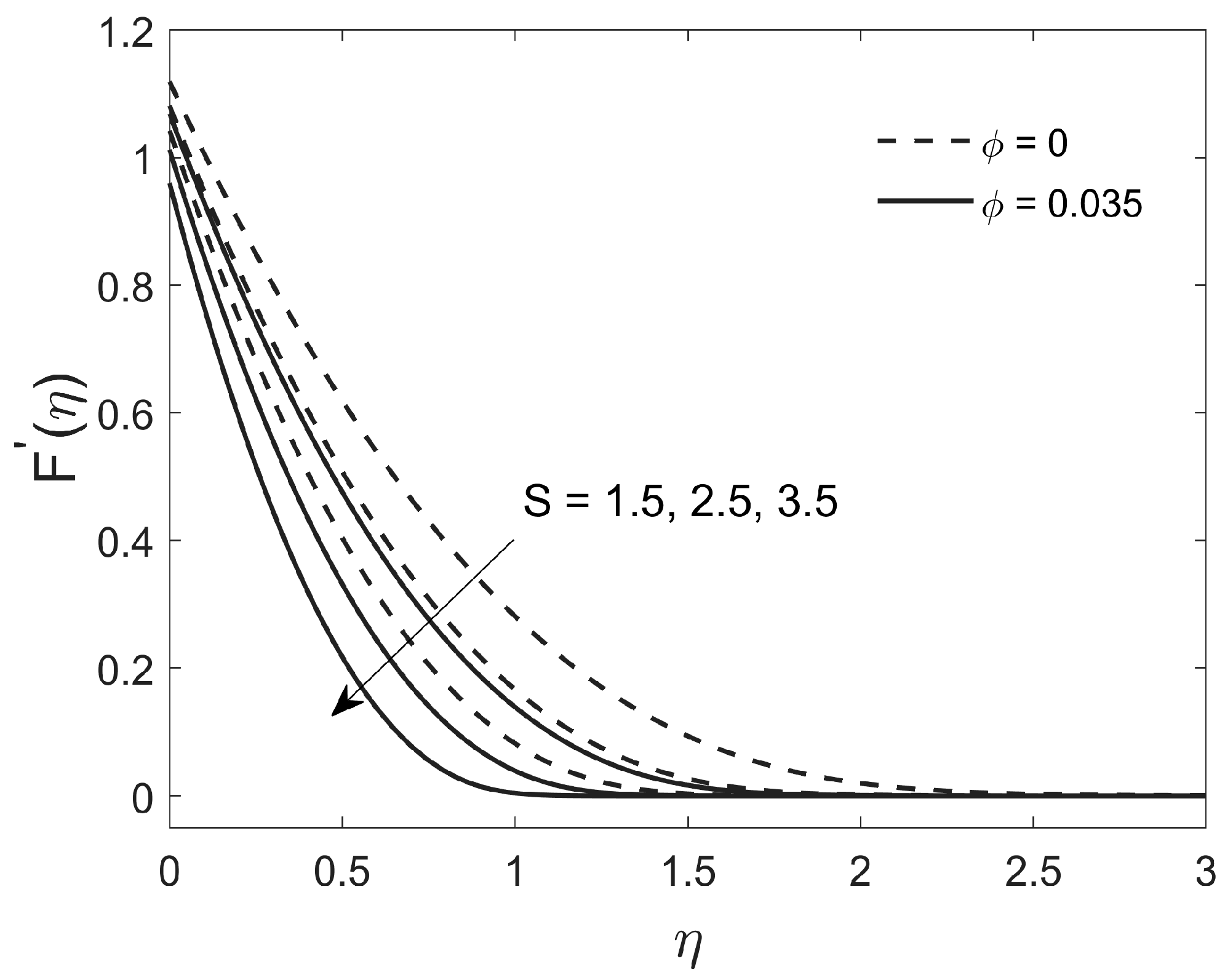

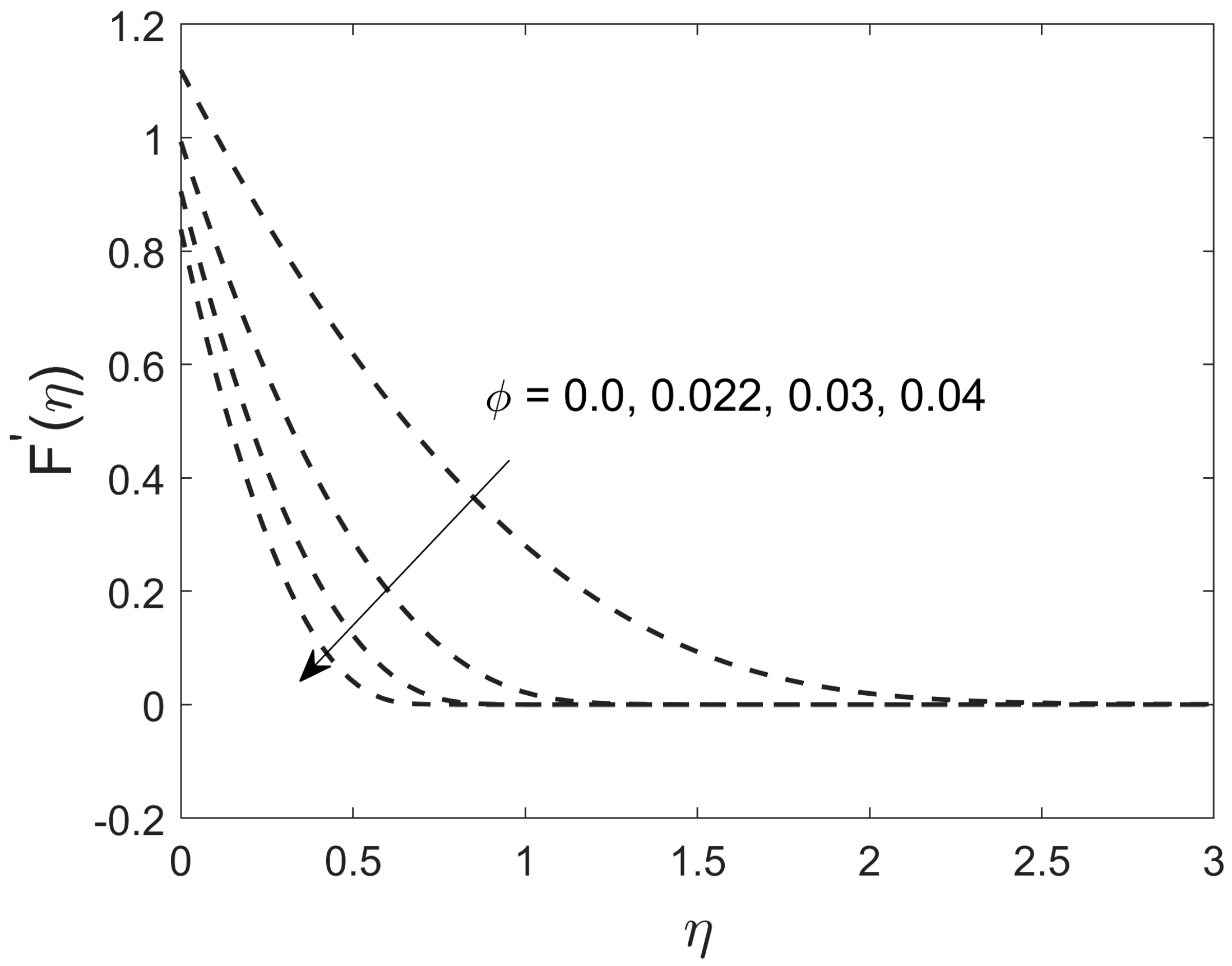
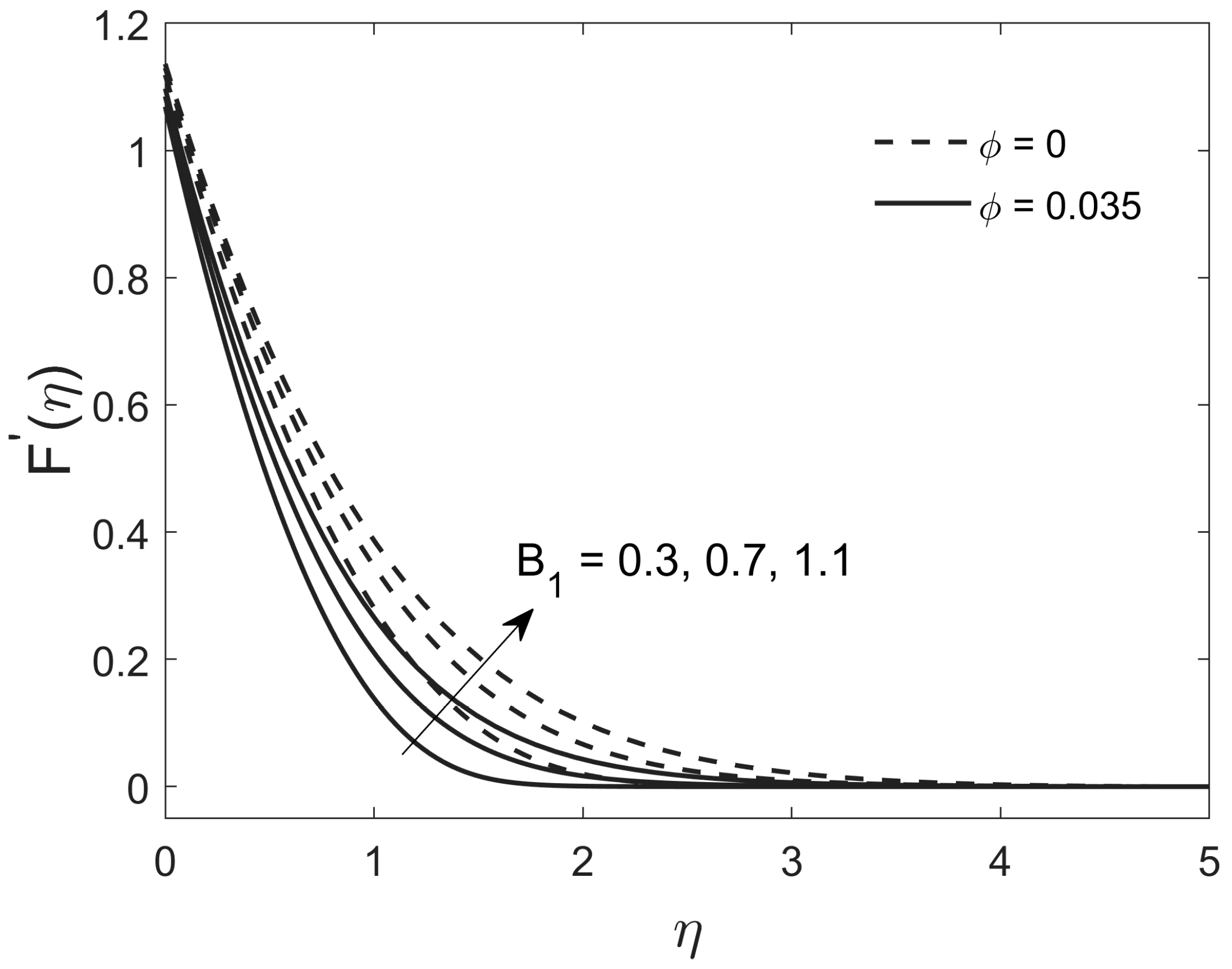

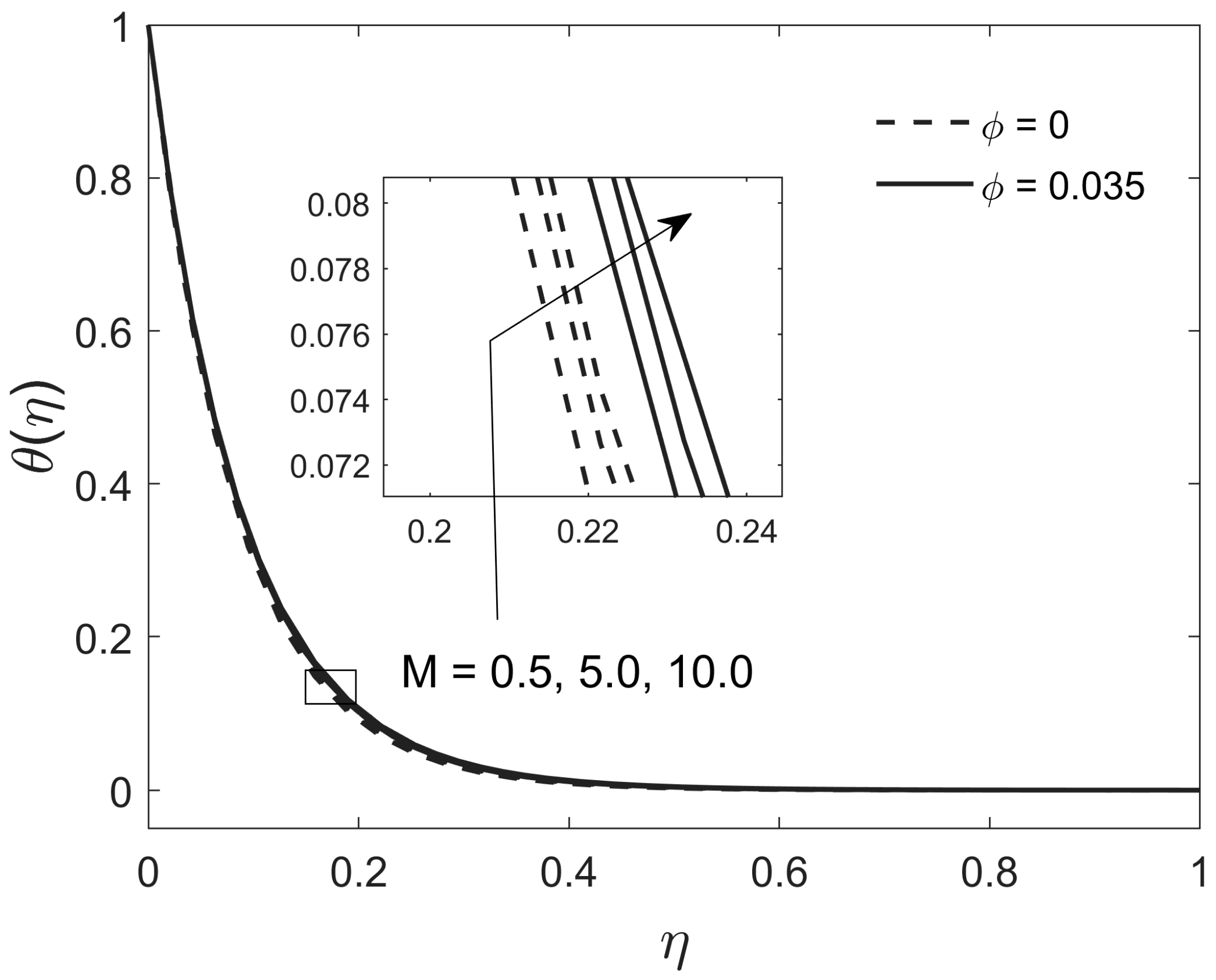
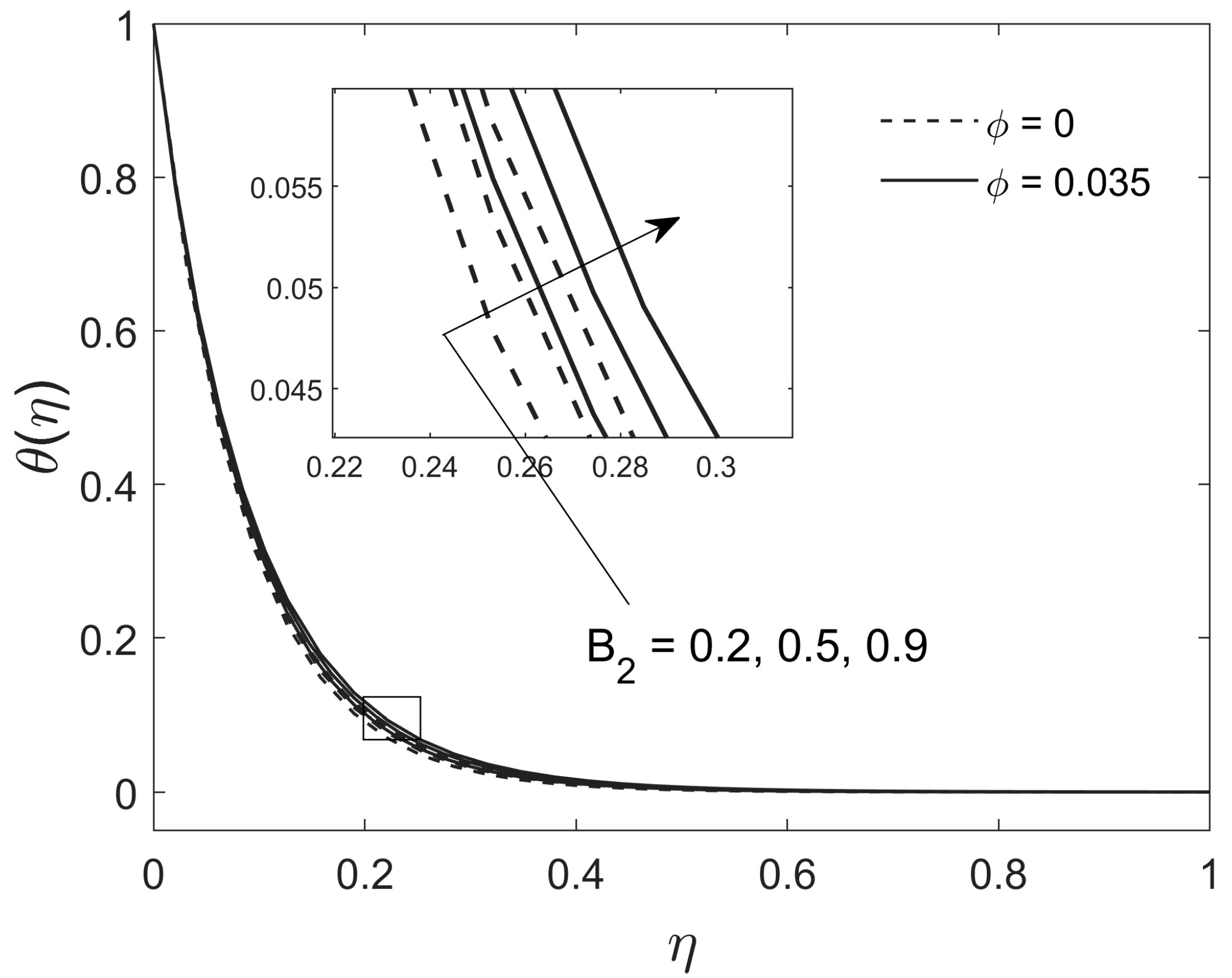
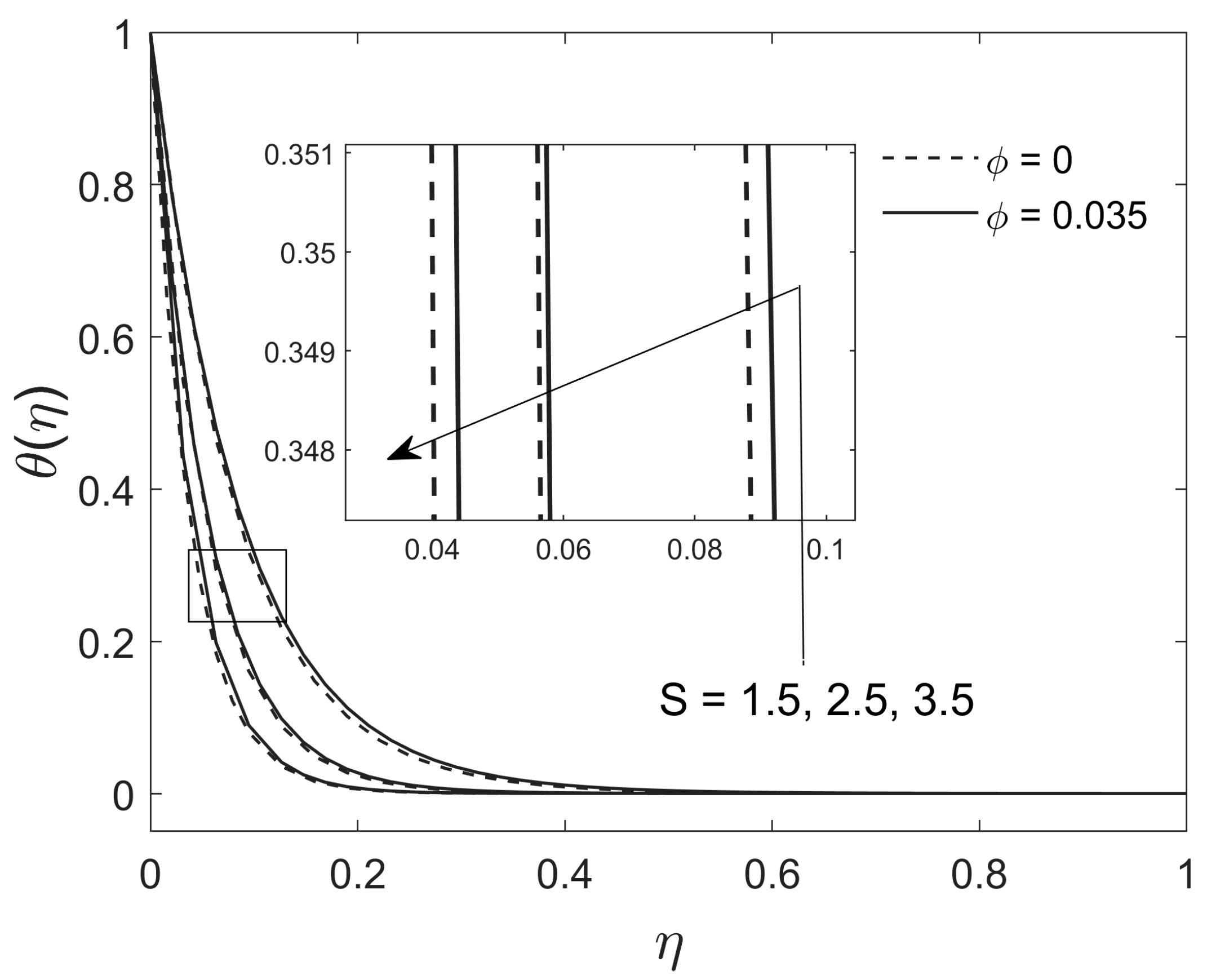

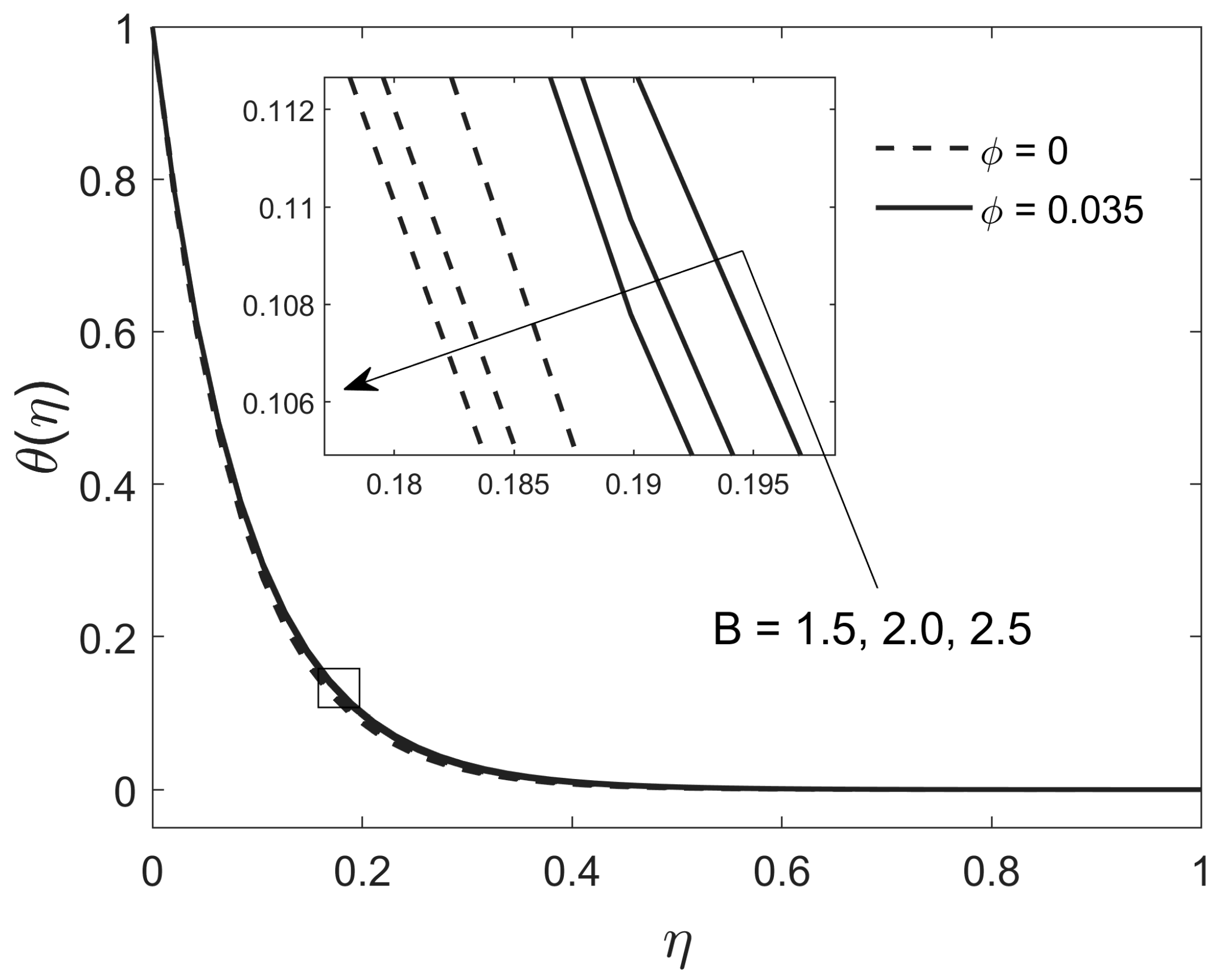

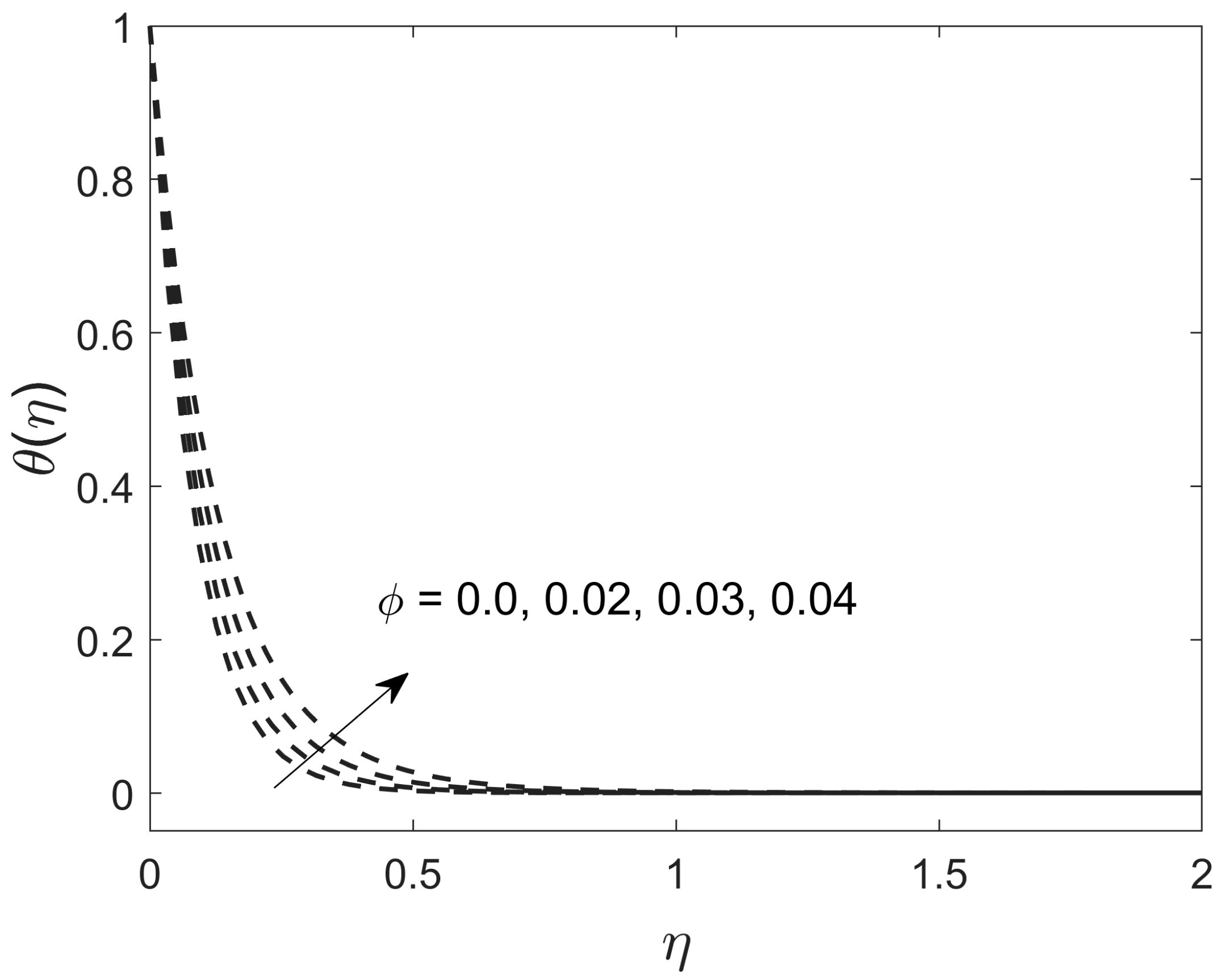

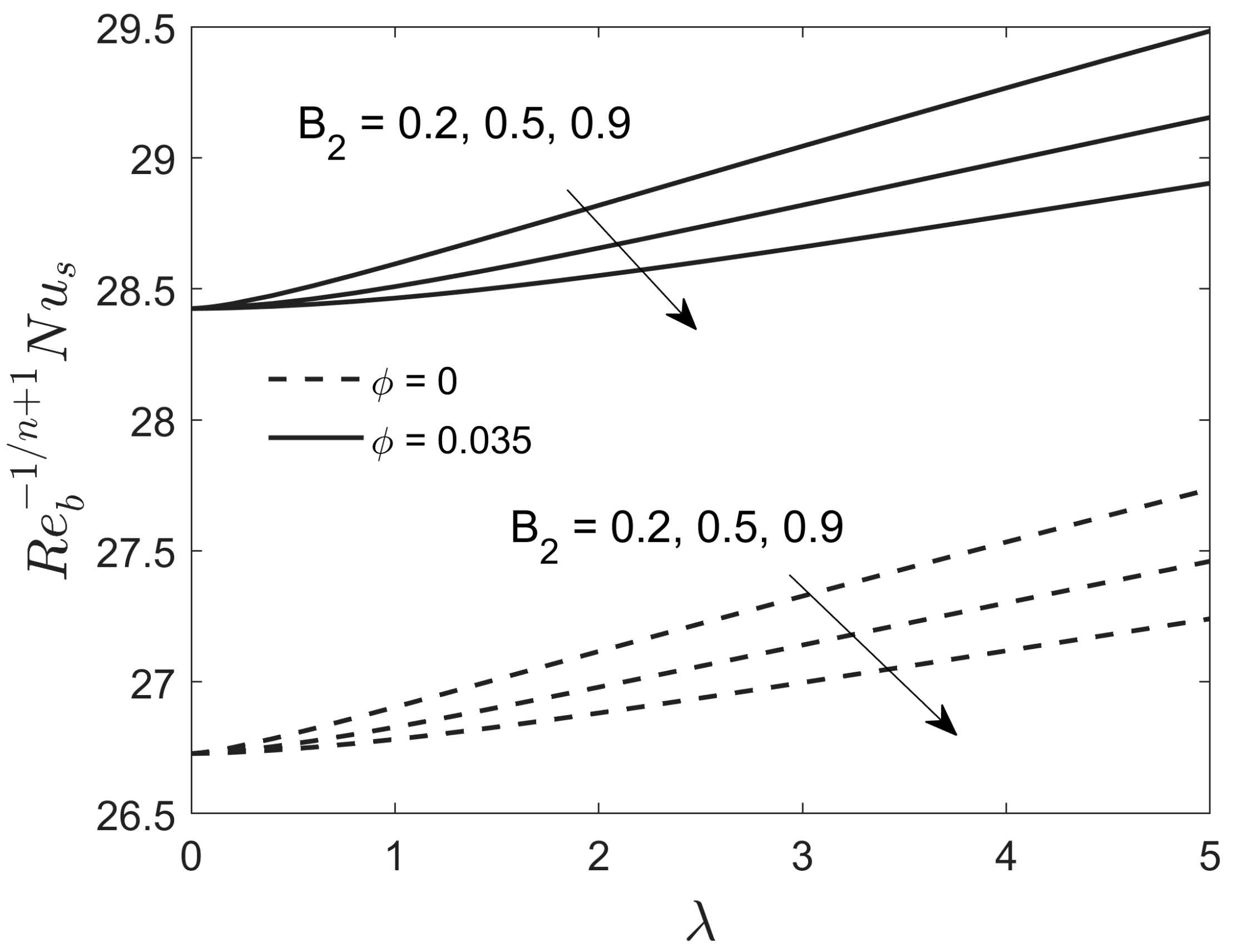
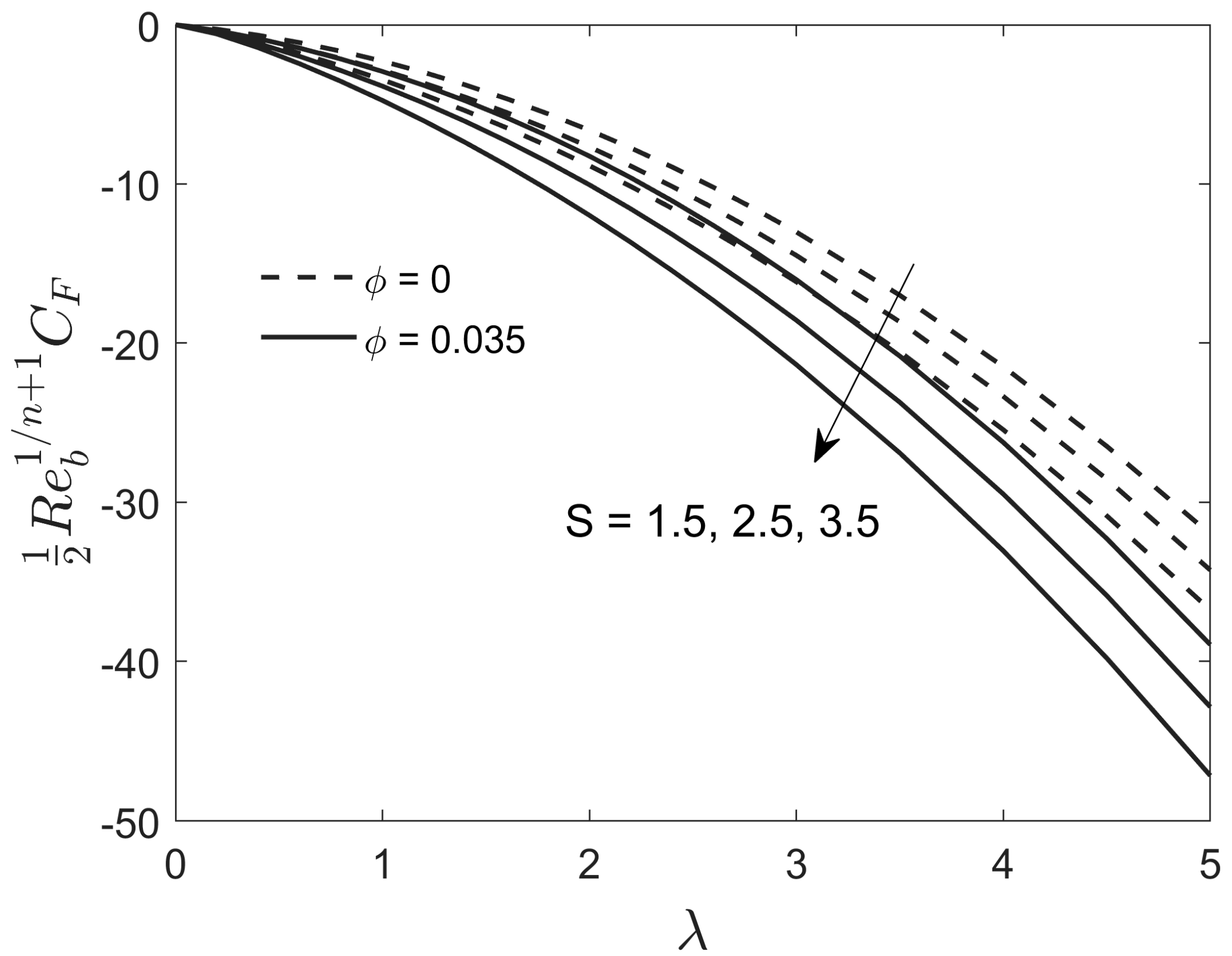
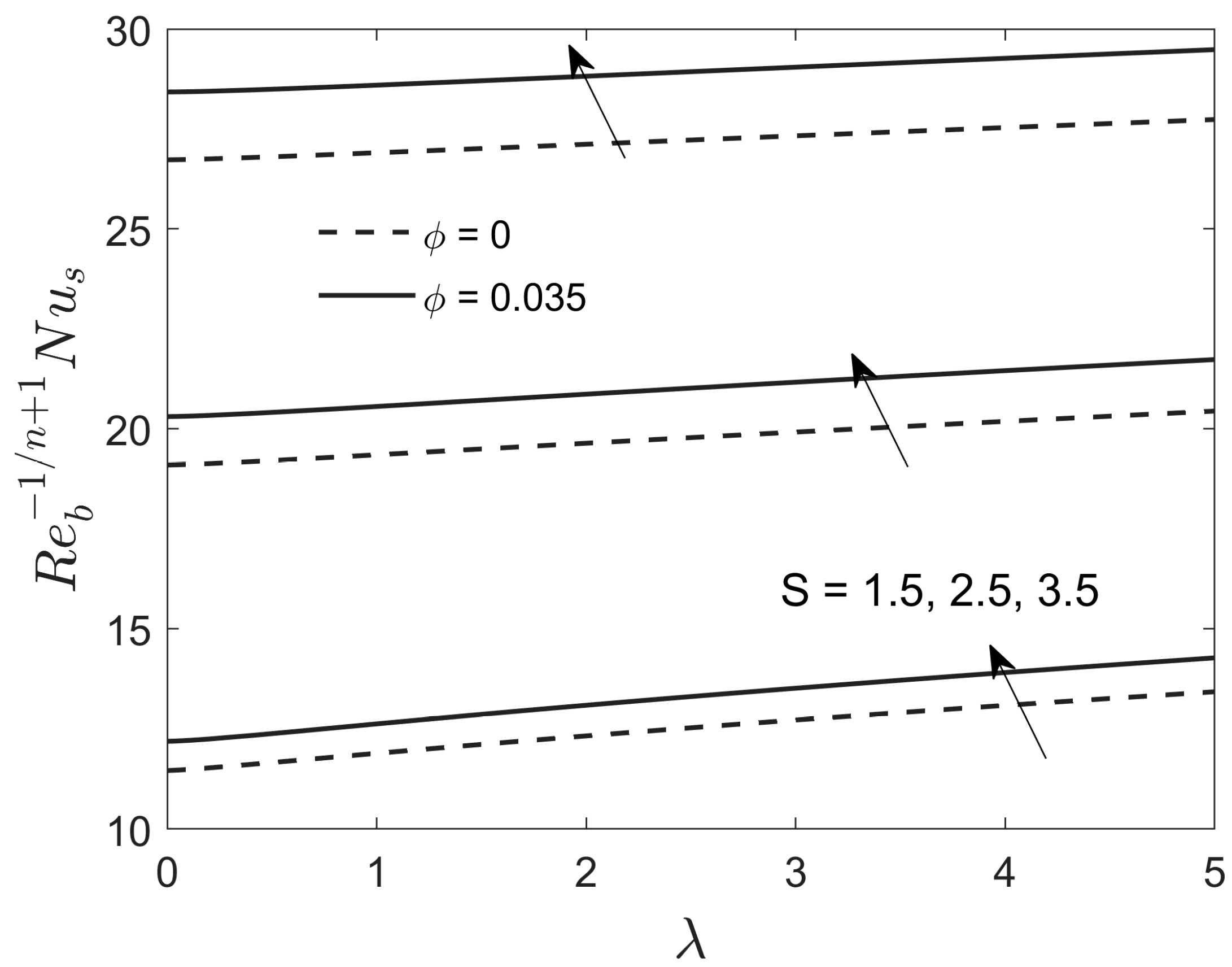
| Thermophysical Properties | Blood | Gold |
|---|---|---|
| ρ (kg/m3) | 1050 | 19,300 |
| cp (J/kgK) | 3617 | 129 |
| (S/m) | 1090 | 4.1 × 106 |
| k (W/mK) | 0.52 | 318 |
| Saleh et al. [34] | Abbas et al. [35] | Waini et al. [36] | Current Outcome | |
|---|---|---|---|---|
| 5 | 1.15076 | 1.15763 | 1.15077 | 1.15756 |
| 10 | 1.07172 | 1.07349 | 1.07173 | 1.07347 |
| 20 | 1.03501 | 1.03561 | 1.03501 | 1.03566 |
| 30 | 1.02315 | 1.02353 | 1.02316 | 1.02353 |
| 40 | 1.01729 | 1.01759 | 1.01730 | 1.01704 |
| 50 | 1.01380 | 1.01405 | 1.01381 | 1.01440 |
| 100 | 1.00687 | 1.00704 | 1.00687 | 1.00703 |
| 200 | 1.00342 | 1.00356 | 1.00343 | 1.00354 |
| 1000 | 1.00068 | 1.00079 | 1.00068 | 1.00069 |
| Roşca et al. [33] | Current Outcome | ||
|---|---|---|---|
| Numerical Outcome | Analytical Outcome | ||
| −0.5 | 0.85289 | 0.85355 | 0.85365 |
| −0.6 | 0.9786 | 0.97947 | 0.97966 |
| −0.7 | 1.08255 | 1.08340 | 1.08382 |
| −0.75 | 1.12366 | 1.12500 | 1.12563 |
| −0.8 | 1.15619 | 1.15777 | 1.15879 |
| −0.9 | 1.18214 | 1.18460 | 1.18796 |
| −0.95 | 1.15876 | 1.16242 | 1.16340 |
| −0.99 | 1.08018 | 1.08900 | 1.09448 |
| 1.5 | 0.5 | 1.5 | 0.3 | 2.0 | 5.92616 | 8.10476 | 27.00936 | 28.70528 |
| 1.7 | - | - | - | - | 7.04118 | 9.58888 | 27.05197 | 28.75033 |
| 1.9 | - | - | - | - | 8.23084 | 11.15728 | 27.09459 | 28.79556 |
| 1.5 | 0.5 | 1.5 | 0.3 | 2.0 | 5.92616 | 8.10476 | 27.00936 | 28.70528 |
| - | 5.0 | - | - | - | 7.56336 | 9.32326 | 26.98816 | 28.68989 |
| - | 10.0 | - | - | - | 8.74439 | 10.33223 | 26.97428 | 28.67789 |
| 1.5 | 0.5 | 1.5 | 0.3 | 2.0 | 5.92616 | 8.10476 | 27.00936 | 28.70528 |
| - | - | 2.0 | 5.82099 | 8.04389 | 27.00762 | 28.70287 | ||
| - | - | 2.5 | 5.76707 | 8.01154 | 27.00647 | 28.70138 | ||
| 1.5 | 0.5 | 1.5 | 0.3 | 2.0 | 5.92616 | 8.10476 | 27.00936 | 28.70528 |
| - | - | - | 0.7 | - | 6.29542 | 8.47280 | 27.01654 | 28.71433 |
| - | - | - | 1.1 | - | 6.70957 | 8.85348 | 27.02234 | 28.72237 |
| 1.5 | 0.5 | 1.5 | 0.3 | 2.0 | 5.92616 | 8.10476 | 27.00936 | 28.70528 |
| - | - | - | - | 4.0 | 5.92617 | 8.10476 | 15.74498 | 16.92315 |
| - | - | - | - | 6.0 | 5.92617 | 8.10476 | 11.14985 | 12.03202 |
Publisher’s Note: MDPI stays neutral with regard to jurisdictional claims in published maps and institutional affiliations. |
© 2021 by the authors. Licensee MDPI, Basel, Switzerland. This article is an open access article distributed under the terms and conditions of the Creative Commons Attribution (CC BY) license (https://creativecommons.org/licenses/by/4.0/).
Share and Cite
Khan, U.; Zaib, A.; Ishak, A. Magnetic Field Effect on Sisko Fluid Flow Containing Gold Nanoparticles through a Porous Curved Surface in the Presence of Radiation and Partial Slip. Mathematics 2021, 9, 921. https://doi.org/10.3390/math9090921
Khan U, Zaib A, Ishak A. Magnetic Field Effect on Sisko Fluid Flow Containing Gold Nanoparticles through a Porous Curved Surface in the Presence of Radiation and Partial Slip. Mathematics. 2021; 9(9):921. https://doi.org/10.3390/math9090921
Chicago/Turabian StyleKhan, Umair, Aurang Zaib, and Anuar Ishak. 2021. "Magnetic Field Effect on Sisko Fluid Flow Containing Gold Nanoparticles through a Porous Curved Surface in the Presence of Radiation and Partial Slip" Mathematics 9, no. 9: 921. https://doi.org/10.3390/math9090921







